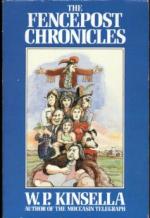|
This section contains 187 words (approx. 1 page at 300 words per page) |

|
While the framework of The Fencepost Chronicles suggests Sherwood Anderson's Winesburg, Ohio (1919), Kinsella's narrator, Silas Ermineskin, recalls Mark Twain's Huck Finn and J. D. Salinger's Holden Caulfield. All are concerned with telling the truth and trying to understand the world around them. Not as cultured or sophisticated as Holden, Silas is closer to Huck's primitive nature; neither is corrupted by people or their experiences.
The Fencepost Chronicles is Kinsella's fifth collection of native American stories. All are narrated by Silas Ermineskin and set on the Hobbema Reserve.
These unifying devices, along with the reappearance of characters in the later stories, creates a novelistic "world," reminiscent of William Faulkner's Yoknapatawpha County, Mississippi, or William Kennedy's Albany, New York.
On a more universal level, The Fencepost Chronicles belongs to the novelistic tradition in the American novel of the classic confrontation between European and native American cultures...
|
This section contains 187 words (approx. 1 page at 300 words per page) |

|




